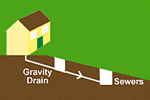Call us on+44 (0)1527 529809
Different Sewage Treatment Systems – simply explained!
- Cesspool
- Septic Tank
- Conventional Filter Bed System
- Modern Sewage Treatment Unit
- Modern Reed Bed
- Gravity Drain
- Pumping System
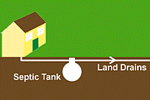 Cesspool
Cesspool
A Cesspool is a sealed underground tank where all the sewage from a property is stored. The Cesspool when full, at approximately monthly intervals, will need emptying by a tanker contractor and must therefore have adequate capacity. Approval to construct a cesspool is required from the Local Authority under the Building Regulations.
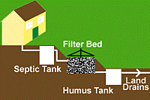 Septic Tank
Septic Tank
In a Septic Tank system, the modern type of tank, usually in the shape of a bottle, has advantages in that it settles and partially digests the settled sewage. However the effluent from a correctly sized tank still contains about 70% of the original polluting matter. This pollution can be further reduced by discharging the liquid into a soakaway system of, for example, land drains after the tank, which allows the ground to treat the sewage pollutants. Details of how the ground may be used are contained in BS 6297. A percolation test will be required to determine whether or not the ground will absorb the liquid and remove the pollutants. If the ground strata cannot accept the liquids properly (i.e. CLAY ground is generally not suitable) then it is possible that the land drains will become blocked. The septic tank should be emptied at least annually. A consent will be required for a new installation.
If a septic tank and land drainage system are unable to treat the sewage, then one of the following sewage treatment systems must be used to remove a substantial amount of the pollution contained in the sewage, and protect the environment.
 Conventional Sewage Treatment Plant
Conventional Sewage Treatment Plant
In a Conventional Filter Bed System, of which there are many in existence, the sewage has about 95% of its polluting matter removed. The primary settlement (or septic) tank removes gross solids, the filter bed biologically treats the sewage, and the humus tank settles out the fine solids. The unit usually requires no electrical power, but a considerable fall across the site is necessary. The system must be correctly designed, at least in accordance with BS 6297, to ensure that the polluting matter is properly removed. This system will require maintenance as well as a periodical emptying of the tanks. A consent will be required from the Local Authority and the Environment Agency.
 Modern Packaged Sewage Treatment Plant
Modern Packaged Sewage Treatment Plant
A Modern Package Sewage Treatment System comprises of a small electrically driven packaged plant, usually all contained in one tank or housing. The sewage is first settled to remove the gross solids and then biologically treated in a filter bed, rotating discs, or by air injection, with a final settlement stage to remove the fine solids. The effluent can be discharged about 95% clean, to a land drainage system or watercourse, (subject to Local Authority and Environment Agency Consents). Maintenance and emptying of the plant will be required at regular intervals. There are numerous variants of packaged plants available on the market.
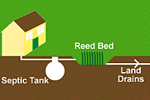 Sewage Treatment by Reed Beds
Sewage Treatment by Reed Beds
A Modern Reed Bed sewage treatment system can successfully treat sewage to the required standards. It usually comprises of a settlement tank to remove gross solids, followed by either vertical or horizontal flow, specially prepared reed beds of specifically reared reeds. These selected reeds have the capability to transfer oxygen from the stems to the rhizomes (roots) where biological action purifies the sewage. The resulting effluent which will be almost clean, can be discharged to a land drain or watercourse (subject to Local Authority and Environment Agency consent.) The system can be operated without power if an adequate fall is available across the site, and generally the only maintenance required is regular emptying of the tanks.
Other Methods of Disposing Sewage
Gravity Drain
A Gravity Drain connection to the main sewers may be possible from either single or multiple properties, if there are some Water Company adopted sewers nearby. Care should be exercised to ensure that the system will be adequately cleaned by the gravity flows. A consent will be required from the Local Authority and/or Water Company.
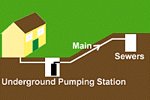 Pumping Station
Pumping Station
If it is economic, it may be possible to install an underground Pumping Station to discharge all the sewage to the nearby Water Company adopted sewers. These special sewage pumps can lift the sewage to practically any height and distance. A consent will be required from the Local Authority and/or Water Company. Regular maintenance of the pumps and system will also be required.
Trade Effluents
There are many types of effluents from commercial and industrial premises that can be successfully treated before discharging the resulting effluent into Rivers, Watercourses, or Sewers. However very specialist advice is required before this can be contemplated, as a Trade Effluent Consent will be required from either the Water Company or the Environment Agency.
Agricultural effluents can also be treated prior to discharge into the land or watercourses, providing suitable means are taken to reduce the pollution loads. Specialist advice is required before this is undertaken as an effluent consent will be required from the Environment Agency.
© 2025 SPE Ltd | Privacy Policy | Quality Policy | Environmental Policy | Designed by SPE Ltd

